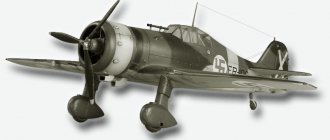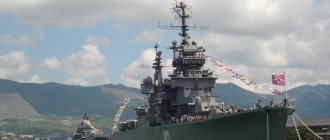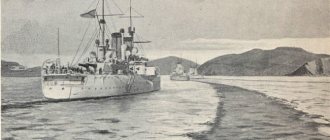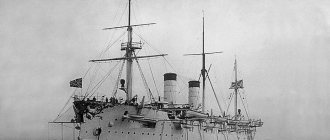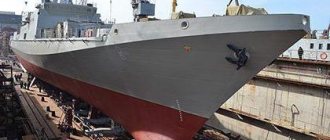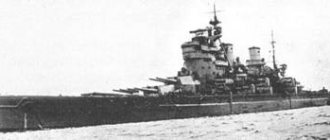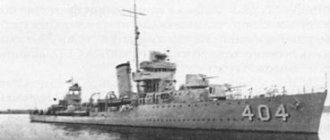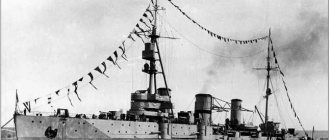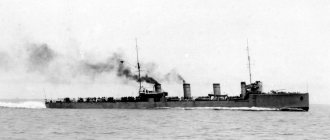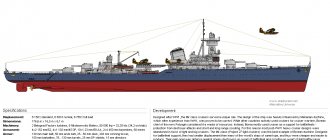Home » Alternative shipbuilding - Fleets that never existed » Alternative Russian cruisers for the Russo-Japanese War
Alternative shipbuilding - Fleets that never existedAlternative shipbuilding - Fleets that never existed
boroda 04/10/2020 5550
16
in Favoritesin Favoritesfrom Favorites 10
I found a very interesting topic on FAI dedicated to alternative shipbuilding. The author is a colleague of Chukchi. The author of all illustrations is a colleague of Shvambran.
So here it is. On April 8, 1894, General Pestich made a report (https://nilsky-nikolay.livejournal.com/718824.html), according to which it is reasonable not to build battleships at all, but to build unarmored ships of 10 thousand+ tons, armed with 80 6dm. rapid-firing guns (about 40 on each side). According to the author's idea, battleships have no more than 50% of their sides covered with armor, and cruisers have even less. Therefore, the proposed ship will shoot more accurately (since 1 gauge is easier to control and aim) and faster. Consequently, in battle he will destroy the opponent’s unarmored part and drown him before he himself receives noticeable damage from the enemy’s few 12 and 8 inch guns. There are a lot of glitches in the reasoning, however, a variation of the proposed tactics worked for the Japanese in the Japanese-Chinese and in the REV. Naturally, no one will accept such an offer in its pure form. And first of all, because, for example, at Yalu, although the Chinese battleships were heavily riddled, they did not lose their combat effectiveness (which is why the Japanese retreated). With the advent of upper armor belts (just in the 1890s), this idea completely lost its relevance. But this is about armor, but regarding a single caliber, the proposal is reasonable. So they decided to accept him.
I bring to your attention armored Russian cruisers for the Russo-Japanese War, made according to this philosophy:
Commanders
- 06/26/1894-01/25/1896 - captain 1st rank Silverswan F.N.
- 01/25/1896-03/27/1900 - captain 1st rank Domozhirov, Alexander Mikhailovich
- 03/27/1900-09/09/1902 - captain 1st rank Serebrennikov, Pyotr Iosifovich
- 09.09.1902-05.01.1904 - captain 1st rank Arnautov, Konstantin Petrovich
- 01/05/1904-10/11/1904 - captain 1st rank Andreev, Andrey Parfenovich
- 10/11/1904-11/20/1906 - captain 1st rank Lilje, Vladimir Alexandrovich
- 02.10.1906-22.04.1907 - captain 1st rank Studnitsky, Ippolit Vladimirovich
- 04/22/1907-10/05/1909 - captain 1st rank Zagoryansky-Kisel, Apollinariy Sergeevich
- 05.10.1909-05.08.1912 - captain 1st rank Blokhin, Konstantin Platonovich
- 05.08.1912-03.08.1914 - captain 1st rank Vorozheikin, Sergei Nikolaevich
- 03.08.1914-27.04.1915 - captain of the 2nd rank (from 25.08.1914 captain of the 1st rank) Podgursky, Nikolai Lyutsianovich
- 04/27/1915-xx.xx.1917 - captain 1st rank Shchetinin A.A.
- in 1918 - captain of the 2nd rank GinterK: Wikipedia: Articles without sources (type: not specified) [ source not specified 2037 days
]
Links[edit]
- Brook, Peter (2000). "Armored Cruiser vs. Armored Cruiser: Ulsan, August 14, 1904." In Preston, Anthony (ed.). Warship 2000–2001
. London: Conway Maritime Press. ISBN 0-85177-791-0. - Frampton, Victor; Head, Michael; McLaughlin, Stephen and Spurgeon, H. L. (2003). "Russian warships near Tokyo Bay." Warship International
.
XL
(2):119–125. ISSN 0043-0374. - Gardiner, Robert, ed. (1979). Conway's World Warships 1860–1905. Greenwich: Conway Maritime Press. ISBN 0-8317-0302-4.
- Gardiner, Robert and Gray, Randal, eds. (1985). Conway's Fighting Ships of the World: 1906–1921
. Annapolis: Naval Institute Press. ISBN 0-85177-245-5. - McLaughlin, Stephen (1999). "From Ruirik to Ruirik: armored cruisers of Russia." In Preston, Anthony (ed.). Warship 1999–2000
. London: Conway Maritime Press. ISBN 0-85177-724-4. - Watts, Anthony J. (1990). Imperial Russian Navy
. London: arms and armor. ISBN 0-85368-912-1.
Incident at the Kronstadt roadstead
On October 1, 1896, mooring tests of the mechanisms were successfully carried out on the Rossiya, and on October 5, the cruiser raised the St. Andrew's flag, pennant and jack for the first time. According to the commander's first drill report, there were 598 privates, 68 non-commissioned officers and 23 officers on the ship.
The departure to the Kronstadt roadstead took place in strong winds (gusts up to 11 points). When approaching the parking lot on the Big Roadstead, a strong gust of wind caused the bow of the cruiser to abruptly throw to the side. It was not possible to stop the demolition of the ship, and its entire side was pressed against the shallows. The cruiser began to hit the ground with waves; several double-bottom compartments had to be flooded to soften the blows. Attempts to refloat the ship with the help of the coastal defense battleship Admiral Ushakov and the squadron battleship Sisoy the Great were unsuccessful - the water level dropped noticeably, and the cruiser sat firmly on the ground.
On the morning of October 27, the head of the Maritime Ministry, Vice Admiral P. P. Tyrtov, arrived at the scene of the accident and approved the decision to deepen the soil under the left side of the cruiser in order to push it into a canal dug nearby. In St. Petersburg, Libau, and Helsingfors, they began to prepare dredging and suction equipment. On the night of October 29, taking advantage of the rising waters, they made another unsuccessful attempt to refloat the cruiser in tow.
On October 30, Rear Admiral V.P. Messer raised the flag on the cruiser and took charge of the work. By November 11, a ditch 7.5-8.5 m deep was made along the left side of the cruiser. At the same time, soil was also removed from under the starboard side. With each rise in water, the battleships Admiral Ushakov and Admiral Senyavin tried to refloat the cruiser, but on November 15 these attempts were stopped.
Despite the approach of winter, he refused [ who?
] from the proposal to prepare the cruiser for wintering in the ice and ordered to speed up dredging work. This work continued even after the Baltic was frozen in ice - the cruiser’s crew cut passages in the ice for dredgers. By December 4, up to 30 m long cruisers were already in clear water. Three wooden hand spiers were installed on the ice 200 m from the side of the cruiser. At 2 o'clock in the morning on December 15, with the next rise in water, the spiers were activated. During the night, “Russia” moved to the side by 25 m and moved forward almost the same amount. In the morning we began to move the cruiser forward, gradually turning it into the channel towards the fairway. At about 2 o'clock in the afternoon it became clear that the cruiser was already in clear water. At 4 o'clock he dropped anchor in the Middle Harbor opposite the Nikolaevsky dock.
Specifications
Ship type: armored cruiser.
Displacement: normal - 6500 tons, full - 7022 tons.
Length: 129.56 m.
Width: 15.9 m (without lining).
Draft: 5.94 m (midship).
Reservations:
- Armor deck - 38/57/76 mm;
- Conning tower - 152 mm;
- Armor weight - 588 tons.
Engines: vertical triple expansion steam engines, 30 Nikloss steam boilers.
Power: 20000/21000 hp when launching into the water.
Propulsion: 2 three-blade propellers.
Speed: 20.5 knots (after repairs in 1903).
Cruising range (10 knots):
- 6100 miles (with a full supply of coal);
- 3270 miles (with normal coal supply).
Crew: 20 officers, 550 sailors and non-commissioned officers.
Weapons:
Artillery:
- 12 × 152 mm/45;
- 12 × 75 mm/50;
- 8 × 47 mm/43;
- 2 × 37 mm/23;
- 2 × 63 mm/19 Baranovsky guns;
- 2 × 7.62 machine guns.
Mine and torpedo weapons:
- 6 × 381 mm TA (2 in stems, 4 onboard, 12 torpedoes);
- 2 × 254 mm TA (6 throwing mines);
- 35 minutes of barrage.
Sources
Type General Admiral Admiral General · Duke of Edinburgh (Alexander Nevsky) Type Dmitry Donskoy Dmitry Donskoy · Vladimir Monomakh Bayan type Bayan (1900) · Bayan (1908) · Admiral Makarov · Pallas (1907) Individual projects Admiral Nakhimov · Memory of Azov · Rurik (1892) · Russia · Thunderbreaker · Rurik (1906)

